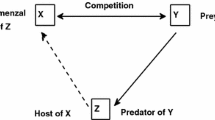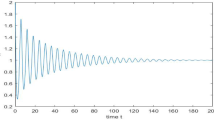Abstract
This article investigates a three-species delayed population model comprising a generalist predator and two prey populations, one of which is commensal. The conditions for the uniqueness and local stability of the equilibria are derived. Additionally, a suitable Lyapunov function is constructed to demonstrate the local stability of the interior equilibrium point in the presence of the delay values. The existence of Hopf bifurcation is investigated with respect to the delay parameters, and the necessary conditions are obtained. The Z-type control mechanism is applied to the system so that the controllers can drive the populations to the desired states. Numerical simulations are conducted to validate the results for specific parameter values.











Similar content being viewed by others
Data Availability
Not applicable.
References
Molles M (2015) Ecology: concepts and applications. McGraw-Hill Education
Arditi R, Abillon JM, Da Silva JV (1978) A predator-prey model with satiation and intraspecific competition. Ecol Model 5(3):173–191
Gourley SA, Kuang Y (2004) A stage structured predator–prey model and its dependence on maturation delay and death rate. J Math Biol 49(2):188–200
Haque M (2011) A detailed study of the Beddington–DeAngelis predator–prey model. Math Biosci 234(1):1–16
Wu R (2018) Dynamic behaviors of a nonlinear Amensalism model. Adv Differ Equ 2018:1–13
Guan X, Chen F (2019) Dynamical analysis of a two species Amensalism model with Beddington–DeAngelis functional response and Allee effect on the second species. Nonlinear Anal: Real World Appl 48:71–93
Fan X, Wang Z, Jiang F (2012) Dynamics of mutualism-competition-predator system with Beddington–DeAngelis functional responses and impulsive perturbations. Abstract and applied analysis
Li TT, Chen FD, Chen JH, Lin QX (2017) Stability of a stage-structured plant-pollinator mutualism model with the Beddington–DeAngelis functional response. Nonlinear Funct Anal
Li M, Gao H, Sun C, Gong Y (2015) Analysis of a mutualism model with stochastic perturbations. Int J Biomath 8(06):1550072
Liu M, Bai C (2020) Optimal harvesting of a stochastic mutualism model with regime-switching. Appl Math Comput 373:125040
Holland NJ (2012) Population dynamics of mutualism. Nat Educ Knowl 3(6):2
Liu M, Bai C (2016) Optimal harvesting of a stochastic mutualism model with Lévy jumps. Appl Math Comput 276:301–309
Gibbs JP, Stanton EJ (2001) Habitat fragmentation and arthropod community change: carrion beetles, phoretic mites, and flies. Ecol Appl 11(1):79–85
Mougeot F, Rodríguez Ramiro J (2019) Commensal association of the common kingfisher with foraging Eurasian otters. Ethology 125(12):965–971
Lang SD, Farine DR (2017) A multidimensional framework for studying social predation strategies. Nat Ecol Evolut 1(9):1230–1239
Veit RR, Harrison NM (2017) Positive interactions among foraging seabirds, marine mammals and fishes and implications for their conservation. Front Ecol Evolut 5:121
Thiebot JB, Weimerskirch H (2013) Contrasted associations between seabirds and marine mammals across four biomes of the southern Indian Ocean. J Ornithol 154:441–453
Mathis KA, Bronstein JL (2020) Our current understanding of commensalism. Ann Rev Ecol Evolut System 51:167–189
Munguia P, Ojanguren AF, Evans AN, Ryckman L, Gemmell B, Cook C, Hensgen G (2009) Is facilitation a true species interaction? Open Ecol J 2(1):83–85
Jiang Q, Liu Z, Wang Q, Tan R, Wang L (2022) Two delayed commensalism models with noise coupling and interval biological parameters. J Appl Math Comput 68(2):979–1011
Lei C (2018) Dynamic behaviors of a stage-structured commensalism system. Adv Differ Equ 2018(1):1–20
Georgescu P, Maxin D, Zhang H (2017) Global stability results for models of commensalism. Int J Biomath 10(03):1750037
Zhang JF (2012) Global existence of bifurcated periodic solutions in a commensalism model with delays. Appl Math Comput 218(23):11688–11699
Ghorai S, Poria S (2017) Pattern formation in a system involving prey-predation, competition and commensalism. Nonlinear Dyn 89(2):1309–1326
Lin Q (2018) Allee effect increasing the final density of the species subject to the Allee effect in a Lotka–Volterra commensal symbiosis model. Adv Differ Equ 2018(1):1–9
Gopalsamy K (2013) Stability and oscillations in delay differential equations of population dynamics, vol 74. Springer Science & Business Media, UK
Hutchinson GE (1948) Circular causal systems in ecology. Ann NY Acad Sci 50(4):221–246
Das S, Das P, Das P (2020) Dynamics and control of multidrug-resistant bacterial infection in hospital with multiple delays. Commun Nonlinear Sci Numer Simul 89:105279
Das P, Das S, Upadhyay RK, Das P (2020) Optimal treatment strategies for delayed cancer-immune system with multiple therapeutic approach. Chaos Solit Fract 136:109806
Das P, Upadhyay RK, Das P, Ghosh D (2020) Exploring dynamical complexity in a time-delayed tumor-immune model. Chaos: Interdiscip J Nonlinear Sci 30(12):123118
Leslie PH (1948) Some further notes on the use of matrices in population mathematics. Biometrika 35(3/4):213–245
Aziz-Alaoui MA, Okiye MD (2003) Boundedness and global stability for a predator-prey model with modified Leslie–Gower and Holling-type II schemes. Appl Math Lett 16(7):1069–1075
Emery SE, Mills NJ (2020) Effects of predation pressure and prey density on short-term indirect interactions between two prey species that share a common predator. Ecol Entomol 45(4):821–830
Logan JD, Wolesensky W (2009) Mathematical methods in biology, vol 96. Wiley
Aziz-Alaoui MA (2002) Study of a Leslie–Gower-type tritrophic population model. Chaos Solit Fract 14(8):1275–1293
Arino J, Wang L, Wolkowicz GS (2006) An alternative formulation for a delayed logistic equation. J Theor Biol 241(1):109–119
Kundu S, Maitra S (2016) Stability and delay in a three species predator–prey system. In: AIP conference proceedings, AIP Publishing LLC, Vol. 1751, No. 1, p 020004
Freedman HL, Rao VSH (1983) The trade-off between mutual interference and time lags in predator–prey systems. Bull Math Biol 45(6):991–1004
Zhang Y, Li Z (2009) Zhang neural network for online solution of time-varying convex quadratic program subject to time-varying linear-equality constraints. Phys Lett A 373(18–19):1639–1643
Patra RR, Kundu S, Maitra S (2022) Effect of delay and control on a predator-prey ecosystem with generalist predator and group defence in the prey species. Eur Phys J Plus 137(1):28
Funding
Not applicable.
Author information
Authors and Affiliations
Contributions
All authors contributed to the study conception and design. All authors read and approved the final manuscript.
Corresponding author
Ethics declarations
Conflict of interest
The authors declare that they have no conflict of interest.
Appendices
Appendix A.
Appendix B.
Rights and permissions
Springer Nature or its licensor (e.g. a society or other partner) holds exclusive rights to this article under a publishing agreement with the author(s) or other rightsholder(s); author self-archiving of the accepted manuscript version of this article is solely governed by the terms of such publishing agreement and applicable law.
About this article
Cite this article
Patra, R.R., Maitra, S. Dynamics of stability, bifurcation and control for a commensal symbiosis model. Int. J. Dynam. Control (2024). https://doi.org/10.1007/s40435-023-01367-3
Received:
Revised:
Accepted:
Published:
DOI: https://doi.org/10.1007/s40435-023-01367-3




